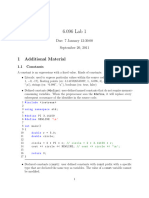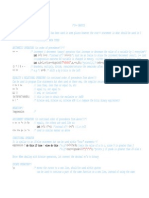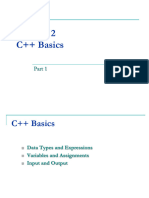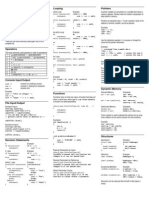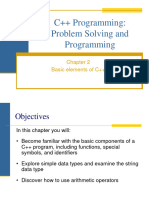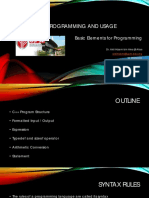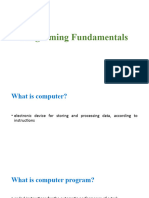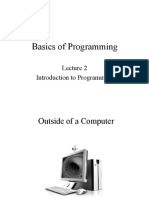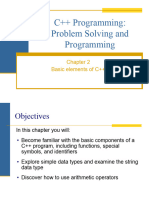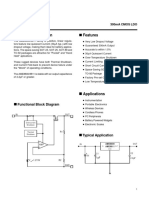Shortcuts (link)
Build
Function
Shortcut Key
Build
Ctrl + F9
Compile current file
Ctrl + Shift + F9
Run
Ctrl + F10
Build and Run
F9
Rebuild
Ctrl + F11
Files
Function
Shortcut Key
New file or project
Ctrl + N
Open existing file or project
Ctrl + O
Save current file
Ctrl + S
Save all files
Ctrl + Shift + S
Close current file
Ctrl + F4 / Ctrl + W
Close all files
Ctrl + Shift + F4 / Ctrl + Shift + W
Remember to save as .cpp!
Escape code
\n
\r
\t
\v
\b
\f
\a
\'
\"
\?
\\
Source: cplusplus
Description
newline
carriage return
tab
vertical tab
backspace
form feed (page feed)
alert (beep)
single quote (')
double quote (")
question mark (?)
backslash (\)
�The big list of commands
Variables
Type
Integer
Real
numbers
String
Command
Int
Usage
Double
String
string mystring;
cin >> mystring;
�Proper coding format
Lecture 0
Basic commands
�#include <iostream>
#include <iomanip>
Using namespace std
Int main ()
{
}
Required for field width,set precision
etc
Allows entry of cout instead of std::cout
Body of the programme
Body outline of a C++ code
OR if you dont want to use
namespace std
#include <iostream>
Using namespace std; Remember
the semi colon!
Int main ()
{
cout<<Hello, this better work!<<
endl;
return 0;
}
#include <iostream>
int main ()
{
std::cout << "Hello World! ";
std::cout << "I'm a C++ program";
return 0;
}
Lecture 1 Data Types
Commands:
Int x,y
Double x,y
Setprecision(g)
Char t
Type of text character with memory size
of exactly one byte (8 bits) => 256
possible values
Range of char type is -128 to 127
Range of unsigned char is 0 to 255
Difference between char and unsigned
char:
Declared as char => Left-most bit is
considered a sign bit. If sign bit =1, it is
negative
Declared as unsigned char, then there
is no sign bit
Bool v
Declare two integer variables x and y
Declare two double-precision floatingpoint
Use g-digit precision (make sure
<iomanip> is included)
Declare a character variable t (Strings)
Two ways
Eg char x1=A or char x2=65; The
values of x1 and x2 are the same.
Use int(xn) to reveal the integer of x1
Declare a Boolean variable v (True or
�false)
Two ways of defining variables
At the start
#include <iostream>
using namespace std;
After declaring the variables
#include <iostream>
using namespace std;
int main()
{int x=30,y=50,z=70,sum;
sum=x+y+z;
cout<<sum<<endl;
return 0;
}
int main()
{int x,y,z,sum;
x=30;
y=50;
z=70;
sum=x+y+z;
cout<<sum<<endl;
return 0;
}
Computer data
-Bit
Only one of two values (0 and 1)
-Byte
A byte contains of eight bits b7 b6 b5 b4 b3 b2 b1 b0
Two possible values of each bit => 2^8 = 256 possible values for each byte
This is the Base-2 (binary) number system
Base-10 number system
Eg The value of 326 = 3x10^2 + 2x10^1 + 6x10^0
For a 4-bit binary number b3 b2 b1 b0, its decimal value is:
B3x2^3
Points to take note when using char
Code used:
Cout<<z1 is <<z1<<Its integer value is <<int(z1)<<endl
Cout<<z2 is <<z1<<Its integer value is <<int(z2)<<endl
�Two cases showing the dangers:
Char y1=9 char y2=9
The values of y1 and y2 are different
(using int(x))
Character with integer value 9 is not
printable
Char z1=35 char z2=35
Char z1: will give us an overflow
Char z2:two characters cannot be
stored into one byte, only 5 is stored
Result:
Y1 is 9 its integer value is 57
Y2 is blank its integer value is 9
Result:
Z1 is # its integer value is 35
Z2 is 5 its integer value is 53
Data type: bool
Boolean type with only two possible values, and the memory size is one byte
The value of a bool variable is true or false
-Boolean false is stored as an integer with value 0
-Boolean true is stored as an integer with value 1
Eg bool x;
X=true;
Cout << x is <<x<<endl
Result: x is 1
Note that when a non-zero value is assigned to a bool variable, it is the same as
assigning 1 to that variable which gives true
Data type: Int
4 Types:
Short int
Int
Long int
Long long int
Eg int x,y;
2
4
4
8
bytes
byte
bytes
bytes
X=56
Y=76.89
Cout<<x is <<x<<endl
Cout<<y is <<y<<endl
Gives us x is 56, y is 76 (Only stores the integer portion)
�Data type: Double
-Specified in either of two formats (6-digit precision)
Fixed point format: 34.567
Scientific format: 5.71e103
Lecture 2 - Operators
Filler
Operators Commands and observations
operator
description
addition
subtraction
multiplication
division
modulo
+
*
/
%
Increments (++ and --)
Int x,y;
x=3
Order of increments matter!
y=++x
Increment of x by 1. X: 3 => 4
y is x y=4
X contains 4, y contains 4
y=x++
Y is x y=3
Increment of y by 1.
X contains 3, y contains 4
Compound assignments (Only use them if all variables are defined)
Expression
x+=y
x-=5
x/=y
Price *= units+1
If a variable is not defined, eg
Equivalent to
x=x+y
X=x-5
X=x/y
Price = price*(units+1)
Int x=3,y;
y+=3 will result in overflow!
But y=+3 is okay, and will result in 3
operator
==
!=
description
Equal to
Not equal to
�<
>
<=
>=
Less than
Greater than
Less than or equal to
Greater than or equal to
http://www.cplusplus.com/doc/tutorial/operators/
Lecture 3 Control Statements
Control statement
While
Sample Code:
Syntax
while (expression) statement
Output:
Explanation:
// custom countdown using while
int main ()
{
int n = 10;
while (n>0) {
cout << n << ", ";
--n;
}
cout << "liftoff!\n";
}
10, 9, 8, 7, 6, 5, 4, 3, 2,
1, liftoff!
Do-while
Sample Code:
do (statement) while (expression)
Output:
Explanation:
// echo machine
int main ()
{
string str;
do {
cout << "Enter text: ";
getline (cin,str);
cout << "You entered: " << str
<< '\n';
} while (str != "goodbye");
}
Enter text: hello
You entered: hello
Enter text: who's there?
You entered: who's there?
Enter text: goodbye
You entered: goodbye
For
Sample Code:
for (initialization; condition; increase) statement
Output (same as while
Explanation:
example)
// countdown using a for loop
int main ()
{
for (int n=10; n>0; n--) {
cout << n << ", ";
}
cout << "liftoff!\n";
}
10, 9, 8, 7, 6, 5, 4, 3, 2,
1, liftoff!
�Switch (and break)
Sample code:
switch (x) {
case 1:
cout << "x is 1";
break;
case 2:
cout << "x is 2";
break;
default:
cout << "value of x unknown";
}
switch (variable)
Depends on the value of
x.
Case n
X is n
Explanation: The command
takes a variable x and gives
different output based on the
cases defined.
Cases need not be case 1,2,3,
can be any integer!
i.e x=5;
case 5 will be called
Lecture 4 and 5 Functions
Sneak preview of whats to come
// function example
#include <iostream>
using namespace std;
int addition(int,int); OPTIONAL. Also called the function prototype.
int addition (int a, int b)
{
int r;
r=a+b;
return r;
}
int main ()
{
int z;
z = addition (5,3);
cout << "The result is " << z;
}
type name ( parameter1, parameter2, ...) { statements }
Where:
- type is the type of the value returned by the function.
- name is the identifier by which the function can be called.
- parameters (as many as needed): Each parameter consists of a type followed by an identifier, with
each parameter being separated from the next by a comma. Each parameter looks very much like a
regular variable declaration (for example:int x), and in fact acts within the function as a regular
variable which is local to the function. The purpose of parameters is to allow passing arguments to the
function from the location where it is called from.
�- statements is the function's body. It is a block of statements surrounded by braces { } that specify
what the function actually does.
Factorial function:
// A recursive function is one that calls itself
int getFactorial(int number)
{
int sum;
if(number == 1) sum = 1;
else sum = (getFactorial(number - 1) * number);
return sum;
// getFactorial(2) [Returns 2] * 3
// getFactorial(1) [Returns 1] * 2 <This value goes above>
// 2 * 3 = 6
Lecture 6 Arrays and random numbers
Declaring arrays two ways:
Int bar[3]={n1,n2,n3} 3 elements only
Int bar[]={n1,n2,n3,...,nk } Let the compiler decide the number of elements

